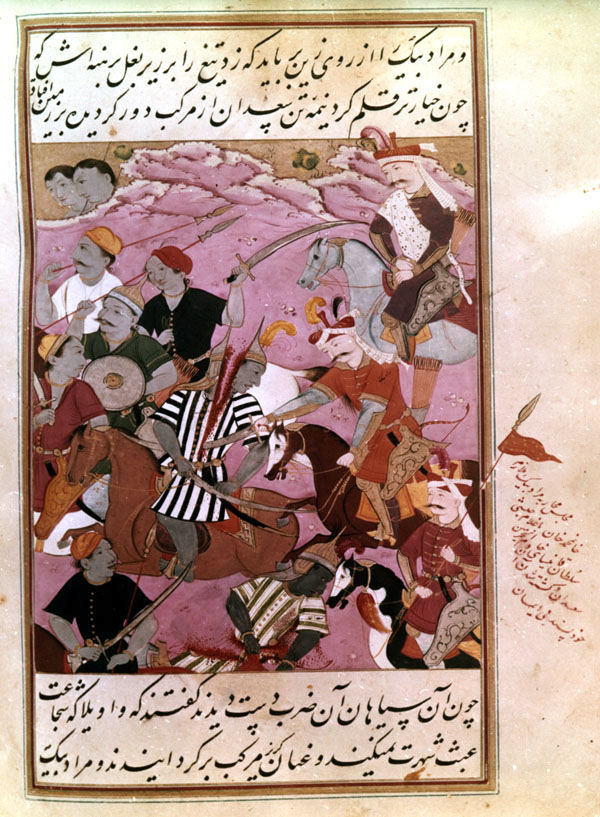)
Morād Beg Kills the Ethiopian Slave
The ʿālām-ārā-ye šāh esmāʿil relates the following story. In the neighboring Arab countries the accomplishments of Shah Esmāʿil were well known. In the spring the Mamluk ruler of Egypt, Sultan Ḡānisāy Ḵādem al-Haramin, gave a celebration that was attended by an Ethiopian slave named Saʿadān Ḡolom-e Ḥabaši Solṭān, also known as Żujondin. This Ethiopian was well respected by the warriors of Egypt, Syria and Arabia for his ability in combat. At this festivity Żujondin began boasting of his abilities, and claimed he could defeat Esmāʿil in combat. A ḡāzi from Iran who was also present, chastised Saʿadān for boasting idly about a king who was well above his station. The ḡāzi taunted, Saʿadān should challenge a person of equal station such as Khan Moḥammad ʿOstājlu, the Safavid governor of Diār Bakr. Upon hearing these words Saʿadān became angered, and asked Sultan Ḡānisāy for permission to bring Khan Moḥammad back to Egypt. Permission granted, Saʿadān departed with 300 men for the fortress of Ḥamid. It was by coincidence that the dāruǧa of the molāzem of Khan Moḥammad with 70 men had arrived at the castle of Orfa (spelled Āufa in the text) to meet Sultan Qājār, the governor of Orfa. He and his men were wandering the countryside when suddenly they came upon the 300 black men. Saʿadān's messenger explained their mission to the dāruǧa, who replied: “It is a coincidence that you, Saʿadān, should arrive before me. I am also a slave,... of Khan Moḥammad,... and having heard of you had asked to be sent to Egypt to confront you... now I will not have to travel all that way. But I am with only 70 men and you have 300, it is best that we not now fight, but rather you should proceed on to Ḥamid and confront Moḥammad Khan." The messenger conveyed the response to Saʿadān, whereupon the Ethiopian became very proud and advanced on the outnumbered Safavids. There was some skirmishing, and after a few had been injured or killed, Saʿadān moved toward the middle of the combat. The dāruǧa, seeing this, went after him. They exchanged words, then parries, and finally the dāruǧa got very upset, and screaming he cut the zangi’s pride separate from his body with the edge of his sword. Upon seeing this the other ǧāzis all joined in the battle. Many of the Ethiopians were killed, twenty were captured, and the remainder fled.
The ʿālām-ārā-ye šāh esmāʿil places this event (SE-234) just after the death of Sāru Qaplān in 913/1507-8 (folio 87), and well before Bābur’s encounter with Šāhibeg Ḵān (folio 135v), the latter having died in 915/1510. That would place this event in 1508 or 1509. However, the jahāngushā'i-ye ḵāqān-e ṣāḥibibqirān in the British Library (cf. Ms. L, folio 242), suggests a different date. There the subject appears in between the defeat of Abuʾl Ḵeyr Ḵān in 919/1513, and the Battle of Čālderān of 920/1514. Of further note Manuscript L identifies the individual responsible for the death of Saʿadān only as the dāruḡa (governor or police chief) of the molāzem (aide-de-camp) of Khan Moḥammad; Manuscript M gives his name, Morād Beg, and his title as molāzem of Khan Moḥammad.
Morād Beg, in a red tunic, lunges forward to “slice up like a fresh cucumber that person without any religion, the Ethiopian slave”. The Ethiopians are portrayed as warriors with helmets, shields, weapons and outlandish uniforms, but in Ms. L, f.242 are portrayed as aborigines wearing loin cloths and armed with crude weapons. Saʿadān seems to be the more prominent figure being split vertically by Morād’s sword - he is dressed in a black and white striped tunic. A second Ethiopian, dressed identically, lies in the foreground severed in two parts at the waist. An erroneous inscription identifies him as Saʿadān. Altogether nine slaves with skin rendered in gray and features conventionalized as Indians rather than Africans, are portrayed fleeing before the onslaught of Morād Beg, who is accompanied by only two other Safavids. In the upper right, in purple, is a Safavid of higher rank who observes. He wears a leopard skin cape, which seems to be the mantle of the local governor. That would suggest he is Sultan Qājār, the governor of Orfa, who is mentioned in the text as having been in that vicinity. The backdrop is simply a light pinkish-mauve hillside, with a rocky ridge near the top, and beyond it a gold sky.
Location: Reza Abbasi Museum, Tehran, No.77.1.7, folio 114v
Folio size: 35.6 x 21.6 cm. wide (after Mahboubian)
Written surface: 22.5 cm. (scaled) x 13.1 cm. wide.
Painting: 20.3 x 15.6 cm. (after Mahboubian; height appears erroneous; width apparently includes extension into the margin).
Inscriptions: Red in margin describes the event. In black identifies morād beg, and incorrectly identifies the wrong figure as saʿadān.
Painting references: Mahboubian_1972, #923 folio 114v (illustrated).
Text References: See Muntaẓer-Ṣāḥeb_1970, pp.160-64 for this event in the History of Shah Esmāʿil.
Robert Eng
Last Updated: Dec. 15, 2011 | Previous update: Dec. 8, 2010 | Originally published: April 4, 2002
